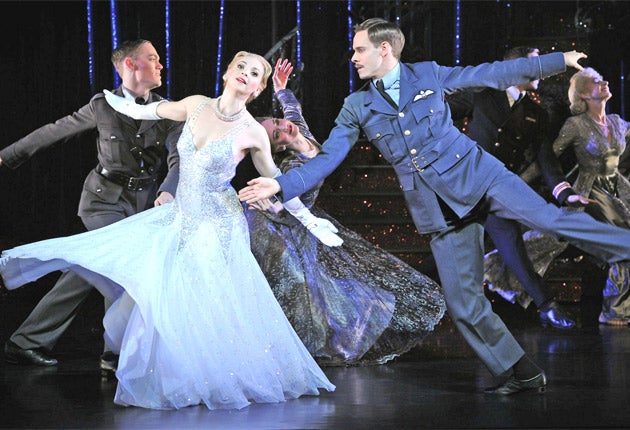Cinderella, Sadler's Wells, London

Matthew Bourne can come across as a brilliant producer of his own weaker work. His Cinderella moves the fairytale into the London Blitz, a monochrome period world lit red by fire. The staging is stylish, from pace to tiny, witty details, but there's little dancing, while Bourne's characters are frustratingly undeveloped.
Created in 1997, Bourne's Cinderella was the follow-up to his breakthrough Swan Lake with male swans. The current Cinderella is a completely new production, substantially revised, marking the 70th anniversary of the Blitz.
It starts with newsreels, with bossy Pathé voices advising us how to behave in an air raid. As Prokofiev's music starts – also on tape – the images go from the unintentional comedy of public information films to footage of London burning.
Though the film clips vanish, we stay in a silver-screen world. Lez Brotherston's new scenery is marvellous, evoking London in black and white and pearly greys. The family home is grandly 1940s, but it's framed by sandbags and blown-out windows.
Bourne and Brotherston move fluently from kitchen to street to the ballroom, which is now a dance hall. Cinderella is the drudge of her more glamorous family, still dreaming of love and escape. Her prince is a wounded RAF pilot, while her fairy godmother becomes a male angel in a white satin suit.
The ball is a night out at the Café de Paris, with ballroom-type numbers as the air raid starts. The prince's search for Cinderella becomes the pilot's search for his lost girlfriend through the rubble. As he goes, Brotherston opens up vistas of wartime London: glimpses of bombed houses, an underground station plastered with "Careless talk costs lives" posters.
The rest of the production is underpowered. For all her Joan Crawford poses, Michela Meazza's Stepmother makes surprisingly little impact. Cinderella's enormous stepfamily are all one-note characters: bitchy sisters and three brothers (one gay, one a foot fetishist, one a schoolboy).
We don't get to know his Cinderella much better. Kerry Biggin, who regularly stars in Bourne's productions, makes a pallid heroine. She starts out mousy with a grey cardigan and glasses, then goes glamorous (though still monochrome) in a silver dress and platinum-blonde hair. Bourne and Biggin don't show us how that feels; it's a good costume change, not a realised dream. Sam Archer's yearning lines give the Pilot a little more character.
There are clever touches in this romance. Dreaming of the ball, Cinderella dances with a dressmaker's dummy. A whirl behind a curtain, and she's dancing with her pilot – though he's still difficult to move, a fantasy figure who won't quite behave. It's a nice idea for a duet, but the choreography is limited.
As a producer, Bourne can use the sweep of Prokofiev's score, but his steps don't get anywhere near it. He struggles to fill the big soloist dances, falling back on vague and repetitive steps. The best dancing comes in the curtain calls – a burst of jitterbug that finally lets these dancers move.
To 23 January (0844 412 4300)
Subscribe to Independent Premium to bookmark this article
Want to bookmark your favourite articles and stories to read or reference later? Start your Independent Premium subscription today.

Join our commenting forum
Join thought-provoking conversations, follow other Independent readers and see their replies